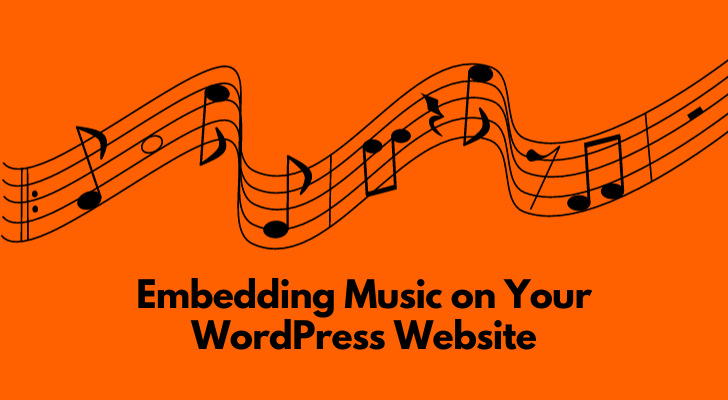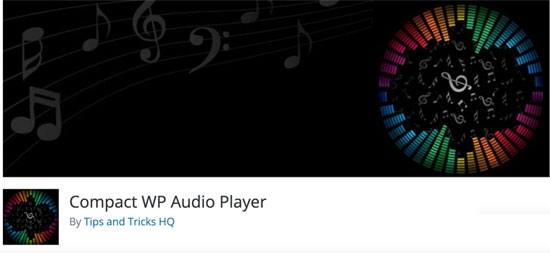So you've got your WordPress site up and running, and now you want to add a dash of musical magic? Uploading entire songs directly to your website? It may seem like a straightforward choice to you, but it's not the most space-efficient. Direct uploads can quickly eat up your web storage, and that will potentially slow down your site's performance.
A smarter way is to embed external sources onto your site. Not only does this save space, but it often offers better playback features. If you're unsure about how to do this, I'm here to walk you through the process. So here we go.

1. WordPress Audio Shortcode
So this is what you think you may be doing - upload your music file. If you really want to do so, WordPress makes adding audio files a breeze with its built-in Audio Shortcode.
So first, upload your music file, and use the following format;
audio src="URL-of-your-audio-file"
Simply replace "URL-of-your-audio-file" with the link of your uploaded music, and voila! Your website visitors will see an audio player and can press play to enjoy your chosen tunes.
2. SoundCloud Integration
SoundCloud is a haven for music lovers and creators. And guess what? Embedding SoundCloud tracks on your WordPress site is super easy.
- First, find the track you wish to embed on SoundCloud.
- Click on the 'share' button and then the 'embed' option.
- You'll get an embed code. Copy that code.
- Paste it into your WordPress post or page in the 'Text' or 'HTML' mode.
Just like that, your SoundCloud track is now a part of your website!
3. Spotify Embeds
Many of us already jam to our favorite beats on Spotify. If you want to share your favorite playlist or song on your WordPress site, Spotify's got you covered.
- Head to Spotify and locate your song or playlist.
- Click the three dots (options) and select 'Share' followed by 'Embed'.
- Copy the provided code.
- Return to WordPress and paste the code into your post or page in the 'Text' or 'HTML' mode.
4. Plugins Galore

The beauty of WordPress lies in its extensive range of plugins. There are plenty of audio and music-related plugins that can help you customize how you showcase your music. Here are a few popular options:
- Audio Album: This plugin lets you display playlists and albums. It’s neat for artists or podcasters!
- Compact WP Audio Player: Want a minimalistic audio player? This plugin offers a compact, non-intrusive player.
- MP3 Audio Player for Music, Radio & Podcast by Sonaar: If you love waveforms and want a responsive audio player, give this one a go.
To install a plugin, head to your WordPress dashboard, go to 'Plugins', then 'Add New', search for your desired plugin, install, and activate.
5. Traditional YouTube Embedding
Even though YouTube primarily offers video content, many use it as an audio platform too. It's common for users to put up lyrical videos, music without videos, podcasts, and more. Here's how to embed a YouTube video (which can essentially function as audio):
- Go to the YouTube video you wish to embed.
- Click on 'Share' and then 'Embed'.
- You'll see a code snippet. Copy it.
- Head over to your WordPress editor. If you're using the block editor (Gutenberg), add a 'Custom HTML' block and paste the code. For the classic editor, switch to 'Text' or 'HTML' mode and paste the code where you want it.
Now, when visitors come to your site, they can play the YouTube video (or audio) right from your page.
6. Using Plugins for YouTube Audio
While embedding the whole video is the straightforward approach, there are plugins available that allow for a more audio-centric display:
- WP YouTube Lyte: This plugin lets you "lazy load" your video, making it faster. But the cool thing? It can show just a thumbnail or an image, making it feel more like an audio player.
- YouTube EmbedPlus for WordPress: A versatile plugin that offers lots of features including creating playlists, which can be great if you want to showcase a series of audios.
To use any plugin, just head to your WordPress dashboard, navigate to 'Plugins', click 'Add New', and then search for your chosen plugin. After installing and activating, follow the plugin-specific instructions to embed your YouTube audio.
Friendly Pointers
- Do note, while YouTube is a fantastic platform, it's primarily designed for video. So if you're embedding a YouTube "audio", it's technically still a video, just without the moving visuals.
- As always, be aware of copyright laws. Just because content is on YouTube doesn't mean it's free to use or embed. Always ensure you have the right permissions.
7. Other External Players
standalone audio player platforms and services that can be embedded into websites. Here are a few examples:
Mixcloud:
This is a streaming platform designed for longer audio tracks and mixes, commonly used by DJs and podcasters. They provide embed codes, making it easy to place their player on your WordPress site.
- Visit Mixcloud and find the track or mix you want to share.
- Click on the "Share" button (usually represented by a curved arrow icon).
- From the pop-up, click the "Embed" tab.
- Copy the provided embed code.
- Go to your WordPress post or page editor, add a 'Custom HTML' block (if you're using Gutenberg) or switch to 'Text' mode (in the classic editor) and paste the code.
Podbean:
While it’s primarily a podcast hosting platform, it also offers sleek audio players that you can embed into any website.
- Navigate to your desired audio track or podcast episode on Podbean.
- Click the "Share" button.
- Choose the "Embed" option to get the embed code.
- Copy the code.
- In your WordPress editor, either use a 'Custom HTML' block or the 'Text' mode and paste the copied embed code.
Clyp:
It's a straightforward platform for uploading and sharing audio. It offers an easy-to-use embed function, so you can place your audio tracks on your WordPress site using their player.
- Find the audio clip you want to share on Clyp.
- Click on the clip to enter its dedicated page.
- Click the "Share" button (represented by an arrow).
- Select and copy the provided embed code.
- Paste this code into your WordPress using the 'Custom HTML' block or 'Text' mode in the editor.
Bandcamp:
Widely used by independent artists and bands to sell their music, Bandcamp provides stylish players that can be embedded, showcasing album art and track listings.
- Browse Bandcamp and locate the track or album you wish to embed.
- Click on the track or album to view its page.
- Find the "Share / Embed" button (usually located below the album art or track waveform) and click it.
- A window will pop up with an embed code. Copy this code.
- On your WordPress site, add the code using the 'Custom HTML' block or 'Text' mode.
Audiomack:
It's another platform where artists, bands, and podcasters can upload their tracks. They also offer an embeddable player.
- Go to Audiomack and select the song or album you want to embed.
- Click the "Share" icon (usually looks like an arrow).
- In the pop-up window, go to the "Embed" tab.
- Choose the player style you prefer and then copy the provided code.
- Insert this embed code into your WordPress post or page using the 'Custom HTML' block or the 'Text' mode.
Which Method Is The Best?
YouTube, definitely, isn't it? In my opinion, it's the best way, and YouTube consistently emerges as a favorite.
Reasons for YouTube's Dominance:
- Universal Recognition: YouTube's vast user base ensures instant familiarity. When visitors see a YouTube player, they immediately know how to use it.
- Broad Content Spectrum: YouTube isn't limited to music. Podcasts, music videos, lyrical visuals, and more make it a hub for diverse audio-visual content. This assortment guarantees you can likely find the content you desire.
- Embedding Simplicity: Integrating YouTube into WordPress is a breeze. Copy the desired video's link, paste it into your post, and WordPress does the rest. No need for complicated embed codes.
- SEO Benefits: Since YouTube is owned by Google, content from this platform can have notable visibility in search results, potentially driving more organic traffic to your website.
- Monetization and Analytics: For those who create content, YouTube provides options for monetization. Plus, its analytics can offer valuable insights into viewer behavior and preferences.
More Than Just Playback
While the primary aim might be sharing music or other content, YouTube's integration offers indirect benefits. The platform's algorithmic recommendations can lead viewers to discover more of your content, encouraging them to explore your channel directly on YouTube after being introduced via your website.
Popular Music Affiliate Programs

Amazon Associates
Amazon Associates is one of the most extensive affiliate programs globally. It covers a vast range of products, including a significant collection of music items—be it CDs, vinyl records, digital tracks, or even musical instruments and gear.
Earning Potential: Commissions vary based on product categories. For music items, the rate usually fluctuates between 4% to 6%. Given Amazon's high conversion rate due to its popularity, consistent promotions can yield satisfactory returns.
2. Guitar Center
As one of the leading music retailers, Guitar Center offers a wide variety of musical instruments and gear. From guitars to drums, recording equipment to DJ gear, there's something for every music enthusiast.
Earning Potential: Affiliates can expect a commission rate of around 6% on most sales. High-ticket items, like premium guitars or electronic drum kits, can result in sizable commissions.
3. zZounds
zZounds is a well-respected online retailer of musical instruments, DJ equipment, and recording gear. They're known for their "Play as you Pay" installment plans, making expensive items more accessible.
Earning Potential: The average commission rate is about 6%. Given the wide range of products and the option for installment payments, affiliates have a good chance to promote and earn from both low and high-ticket items.
4. Musician's Friend
Musician's Friend boasts an extensive inventory ranging from string instruments to sound systems. They often have exclusive deals and a robust rewards program, making them attractive to potential buyers.
Earning Potential: Affiliates typically receive a 4% commission on most sales. However, during promotional events or with exclusive deals, there's potential for increased earnings.
5. Native Instruments
Focusing on the digital side of music, Native Instruments is a powerhouse for music production software and hardware. From software synthesizers to digital DJ setups, they're a go-to for modern music makers.
Earning Potential: Their affiliate program offers a 5% commission on software products and a 2.5% commission on hardware. Given the popularity and price point of many of their offerings, consistent promotion can lead to substantial earnings.


I embedded music and it worked for a few weeks then all the music was deleted. Now I cannot embed music. Why?
Hi Conway, sounds like you may have exceeded your file space usage. Your hosting company may have blocked you. Have you checked with the support?
Thank you for the informative post. I use Spotify a lot but didn’t know you could put it on a website. I’ll definitely try it out. I’ve only seen YouTube videos on websites before. My friend is a musician and sells his music on his website and uses SoundCloud too. I’ll tell him about this post. Thanks for sharing this helpful info.
Thanks for your comment Fadia, to be honest I’ve never had to embed Spotify on my site either, but things like that should be useful for your musician friend for sure. Do let me know if you need any assistance of questions.